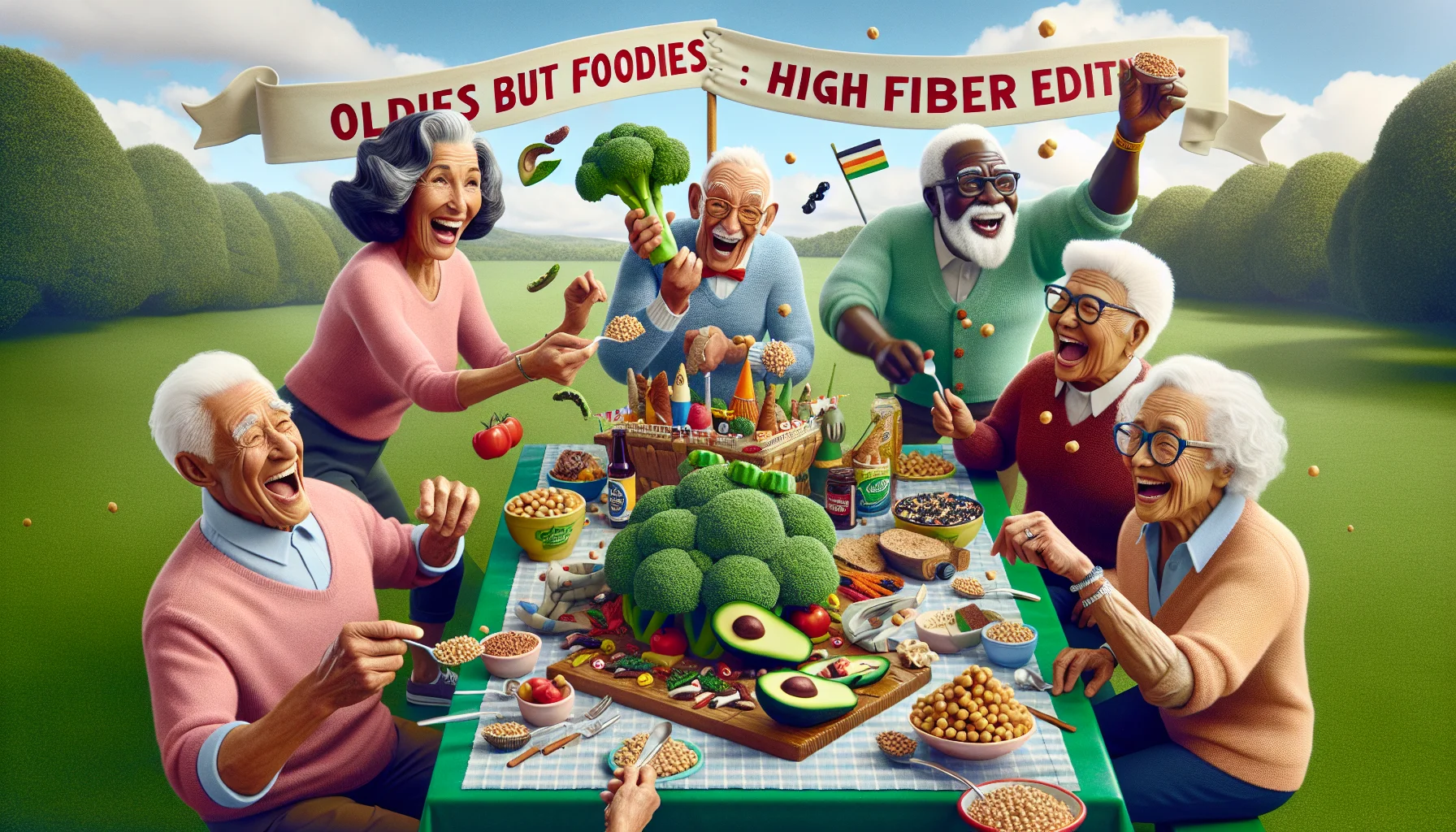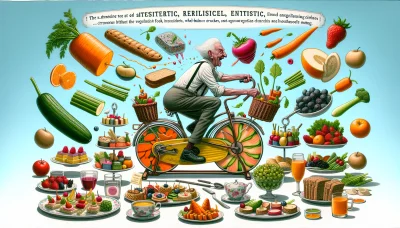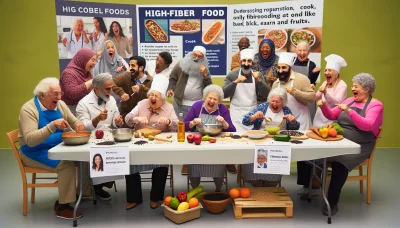List of high fiber foods for elderly Quiz
Test Your Knowledge
Question of
Understanding the Importance of Fiber for Seniors
Health Benefits of High Fiber Foods
Fiber is a powerhouse nutrient, especially for seniors, playing a critical role in maintaining overall health. A diet rich in fiber can significantly reduce the risk of developing chronic diseases. It's not just about digestive health; it's a full-spectrum wellness ally!
When it comes to digestive health improvement, fiber is your go-to solution. It keeps things moving, reducing constipation, which can be a serious issue for many seniors. A high-fiber diet also contributes to a healthy gut microbiome, vital for immune function and nutrient absorption.
Blood sugar regulation becomes increasingly important as we age. Fiber slows down the absorption of sugar, helping to prevent spikes in blood glucose levels after meals. This is crucial for seniors managing diabetes or those at risk of developing the condition.
Managing cholesterol is another arena where fiber shines. Soluble fiber found in oats, fruits, and beans can help lower bad LDL cholesterol levels, thereby protecting heart health. Remember, a happy heart starts with a fiber-rich plate!
Recommended Fiber Intake for the Elderly
Daily fiber requirements are essential knowledge for seniors aiming to optimize their diet. Generally, women over 50 should aim for 21 grams per day, while men need about 30 grams. But remember, these numbers are just starting points!
Adjusting fiber intake with age is crucial since dietary needs evolve over time. As metabolism slows down, maintaining a high-fiber diet can help seniors stay in top shape and manage weight effectively.
- Eat a variety of fiber-rich foods such as fruits, vegetables, whole grains, and legumes.
- Increase fiber intake gradually to avoid gastrointestinal discomfort.
- Stay hydrated to help fiber do its job effectively.
- Consider fiber supplements if dietary changes are not enough.
- Maintain regular physical activity to complement the benefits of a high-fiber diet.
- Consult with healthcare providers before making significant changes to your diet.
Signs of inadequate fiber consumption can be subtle but impactful. Watch out for issues like irregular bowel movements and increased hunger between meals. If you're experiencing these signs, it may be time to reevaluate your fiber intake!
Identifying High Fiber Foods Suitable for Seniors
Categories of Fiber-Rich Foods
Embarking on a journey toward a fiber-rich diet is paramount for seniors, aiming to maintain digestive health and overall well-being. A diverse array of foods brimming with fiber awaits their selection. Understanding the categories is the first step in crafting a diet that's not only beneficial but also enjoyable.
Whole Grains and Cereals are a treasure trove of fiber. Seniors should seek out oatmeal, barley, and brown rice as they are not only fiber-laden but also packed with essential nutrients. Integrating these grains into daily meals can be both seamless and delightful.
Fruits and Vegetables , the colorful heroes of nutrition, offer a spectrum of fiber and vitamins. The key is varietyapples, berries, carrots, and leafy greens all contribute to a well-rounded intake of dietary fiber. They're nature's candy and medicine in one bite!
Legumes, Nuts, and Seeds are the unsung heroes in the world of fibrous foods. Lentils, almonds, chia seedsthey're not just for the health-conscious youth but golden nuggets for senior diets too. With every spoonful comes a burst of energy and vitality.
Selecting Age-Appropriate Fiber Sources
When it comes to seniors, not all fiber sources are created equal. It's about finding that sweet spot where nutrition meets ease of consumption. The goal is to identify foods that deliver the needed fiber without causing discomfort or difficulty in eating.
Easy-to-Chew Options such as cooked vegetables or ripe fruits can be a godsend for seniors with dental issues. These foods provide the necessary fibers while ensuring that mealtime remains a pleasure rather than a challenge.
- Avoid tough skins by choosing peeled fruits or steamed veggies.
- Prioritize soft-cooked legumes like lentils which are gentle on the palate.
- Incorporate whole grain bread that's soft yet rich in fiber.
- Select cereals that are easy to consume, avoiding overly hard or crunchy varieties.
- Serve sizes should be adjusted to smaller portions to prevent overwhelming the digestive system.
Low-Sodium Canned Goods , such as beans and peas, offer convenience without compromising on fiber content. They can be particularly handy for seniors who may find cooking from scratch more laborious.
High-Fiber Snacks like nuts or dried fruits can serve as an excellent between-meal munchies; however, moderation is key here due to high caloric density. They're perfect companions for leisure moments or when energy levels need a little boost.
Incorporating Fiber into Everyday Meals
Breakfast Ideas for a Fiber-Rich Start
High-Fiber Cereals and Oatmeal
Kickstart your day with a punch of fiber by choosing cereals labeled as high-fiber options. Remember, not all cereals are created equal check the nutrition labels for at least 5 grams of fiber per serving. Oatmeal isn't just warm and comforting; it's a fantastic fiber source, too. Boost it with nuts and berries for extra nutritional power!
Fruit-Based Breakfasts
Fruits are an excellent way to infuse your morning routine with fiber, especially when you add them to smoothies or yogurt. Bananas, apples, and berries are your best friends here. But don't stop there throw in some chia seeds or flaxseeds for an even more substantial fiber boost!
Whole Grain Toast Variations
Whole grain bread is a simple swap for a high-fiber breakfast base. Top it with avocado for healthy fats and fiber or add a spread of almond butter for protein plus fiber combo. Get creative with toppings like sliced tomatoes or cucumbers to keep things interesting and nutritious.
- Avoid refined grains: Choose whole grain bread over white bread.
- Add seeds: Sprinkle chia or flaxseeds on top of your toast or oatmeal.
- Mix in nuts: Almonds and walnuts can add crunch and fiber.
- Dont forget the berries: Berries are high in fiber and antioxidants.
- Beware of added sugars: Opt for natural sweetness from fruits rather than sugary spreads.
Dinner Recipes with High Fiber Content
Vegetable-Heavy Dishes
Veggies are not just sides; make them the star of your dinner for a serious fiber injection. Think stir-fries packed with broccoli, bell peppers, and snap peas or salads brimming with dark leafy greens. Roasting vegetables caramelizes their natural sugars, making them irresistibly tasty while still being packed with fiber.
Legume-Based Entrees
Beans and lentils are powerhouses of nutrition, offering both protein and fiber. A chili full of kidney beans, chickpea curries, or lentil stews are not only hearty but also incredibly beneficial for your digestive health. Plus, they're perfect as leftovers, making your next day's lunch prep a breeze!
Whole Grain Pasta and Rice Options
Ditch the white pasta and rice; instead, opt for their whole grain counterparts. Whole grain pasta can be used in traditional Italian recipes or cold pasta salads. Brown rice is versatile serve it alongside stir-fries or use it as a base for rice bowls topped with vegetables and lean proteins.
Managing Fiber Intake with Digestive Sensitivities
Easing into a High Fiber Diet
Gradual Increase of Fiber: Starting with small amounts is key for those with digestive sensitivities. Abruptly adding large quantities of fiber can lead to discomfort or exacerbate sensitive conditions. Begin with a modest intake and gradually ramp it up over weeks or even months.
Importance of Water Intake: Water works in tandem with fiber, helping to ease its passage through the digestive system. As you increase your fiber intake, it's crucial to also boost your water consumption. This combination helps prevent constipation and maintains smooth digestion.
Recognizing Signs of Excess Fiber: Listen to your body's signals. Bloating, gas, or cramping can indicate you've gone too far, too fast. If these symptoms occur, scale back on fiber and increase more slowly, allowing your body to adjust at a comfortable pace.
- Start with an additional 5 grams of fiber per day and observe your body's response.
- Increase water intake by at least one glass for every 5 grams of added fiber.
- If symptoms appear, revert to the previous fiber intake level before the increase.
- Maintain a food diary to monitor fiber sources and your bodys reactions.
Fiber Supplements vs. Natural Sources
Types of Fiber Supplements: There are myriad options when it comes to fiber supplements. Soluble fibers like psyllium are common and beneficial for heart health, while insoluble fibers help with constipation. Choosing the right type is dependent on individual health goals and sensitivities.
Pros and Cons of Supplements: Supplements offer convenience and precise dosage control but may lack the nutritional diversity found in natural sources. They can be a great addition but should not completely replace the variety of fibers found in whole foods.
Integrating Supplements with Diet: It's best to use supplements as a complement to dietary fiber. Balance is essential; aim for a foundation of natural sources such as fruits, vegetables, and whole grains, augmented by supplements as needed to reach your daily goals.
Overcoming Common Dietary Challenges in the Elderly
Addressing Chewing and Swallowing Difficulties
As we age, it's common to encounter issues with chewing and swallowing due to changes in dental health or reduced saliva production. To manage this, opting for soft, high-fiber foods like oatmeal, ripe bananas, and steamed vegetables can be beneficial. These options provide the necessary nutrients without causing discomfort during eating.
Pureed or blended options are fantastic alternatives that ensure seniors receive their full spectrum of vitamins and minerals. Smooth soups, applesauce, and mashed potatoes are not only easy to consume but also allow for a variety of flavors to keep meals interesting.
Employing cooking techniques that soften foods can greatly aid those with chewing and swallowing difficulties. Slow cooking meats until they're tender or roasting vegetables to bring out their natural sweetness can enhance the dining experience for the elderly without compromising on texture.
Soft High-Fiber Foods
Incorporating high-fiber foods into an elderly person's diet is crucial for maintaining digestive health. However, these foods need to be soft enough to chew and swallow easily. Options like well-cooked legumes, avocados, and soft whole-grain breads are excellent choices that provide both nutrition and ease of consumption.
It's important to ensure that these high-fiber foods are prepared in a way that doesn't add unnecessary hardness or complexity. Cooking them until they're soft enough for effortless chewing but still rich in fiber is key to a balanced diet for seniors.
Pureed or Blended Options
Pureed diets don't have to be dull! Creative blending can lead to delicious combinations that excite the palate while providing essential nutrition. Experimenting with different fruits, vegetables, and protein sources can result in tasty purees that ensure dietary requirements are met.
Consistency is vital when preparing pureed foods; they should be smooth enough to swallow with ease but also thick enough to provide satisfaction. Nutrient-dense ingredients like cooked meats or tofu can be finely blended into soups or sauces for added protein.
Cooking Techniques to Soften Foods
- *Steaming: Retains nutrients while making food softer. *Braising: Slowly cooks tougher cuts of meat in liquid until tender. *Stewing: Combines solid food ingredients with liquid and simmers over low heat. *Poaching: Gently cooks delicate foods like fish in a flavorful liquid. *Slow-cooking: Allows for hands-off cooking while ensuring soft results. *Pressure-cooking: Reduces cooking time while yielding tender outcomes.
Enhancing Flavor without Compromising Nutrition
Enhancing flavors in meals is essential for stimulating appetite in the elderly. Herbs and spices offer a healthful way to elevate taste without resorting to excessive salt or sugar which can be detrimental to health. Fresh herbs like basil or cilantro can transform a simple dish into something extraordinary.
Using Herbs and Spices
Utilizing herbs and spices not only adds zest but also provides health benefits. For example, turmeric has anti-inflammatory properties, while cinnamon can help regulate blood sugar levels. Integrating these flavors into meals makes each bite both nutritious and delicious!
Incorporating Flavorful Vegetables
Vegetables needn't be bland; when cooked right they're packed with flavor! Roasting vegetables caramelizes their natural sugars, bringing out a depth of flavor that enhances any meal. Pairing different vegetables based on their flavor profiles can create harmonious dishes brimming with nutrients.
Healthy Cooking Methods
Healthy cooking methods such as grilling, baking, or sauting with a small amount of healthy fats like olive oil can boost flavor without adding unnecessary calories or sodium. Cooking at home allows control over ingredients ensuring meals are flavorful yet nutritiousa win-win situation!
Planning a Balanced High-Fiber Diet for Seniors
Structuring a Daily Meal Plan
Creating a well-structured meal plan is paramount for seniors to ensure they receive adequate fiber and nutrition throughout the day. This involves distributing meals and snacks at regular intervals to maintain energy levels and digestive health. A strong emphasis on fruits, vegetables, whole grains, and legumes can help meet daily fiber requirements.
When planning meals, it's important to consider not just the total daily fiber intake but also the balance of other nutrients. Each meal should offer a variety of foods to provide a spectrum of vitamins, minerals, and macronutrients. Hydration is equally crucial; water aids in the digestion of fiber and should be consumed consistently throughout the day.
Sample Meal Schedules
A sample meal schedule for seniors might include a high-fiber breakfast with oatmeal and berries, a mid-morning snack like an apple or carrot sticks, a lunch featuring a quinoa salad with mixed vegetables, an afternoon snack such as hummus with whole-grain crackers, followed by a dinner that includes grilled fish with brown rice and steamed broccoli.
Portion Sizes and Frequency
Appropriate portion sizes are essential to prevent overeating and ensure that seniors are receiving the right amount of nutrients. Smaller, more frequent meals can aid in digestion and energy regulation. This also helps in maintaining steady blood sugar levels, which is particularly important for diabetic seniors.
Balancing Macronutrients with Fiber
Fiber intake should be balanced with other macronutrients such as proteins, fats, and carbohydrates. A plate model can be used where half the plate consists of fruits and vegetables (high in fiber), one quarter consists of lean protein, and the remaining quarter includes whole grains or starchy vegetables.
Adapting Traditional Diets to Increase Fiber
Seniors often have long-established eating habits that may not include enough fiber. Adapting these traditional diets by incorporating higher-fiber options can improve their nutritional profile without completely altering their familiar foods. It's about making smart substitutions rather than complete overhauls.
Cultural Dietary Considerations
Cultural preferences play a significant role in what seniors are willing to eat. When increasing fiber in traditional diets, it's important to respect these preferences by choosing culturally appropriate high-fiber foods. For instance, using whole grain versions of staple items like rice or bread can subtly enhance fiber content without drastic changes in taste.
Substituting Ingredients in Favorite Recipes
- *Use whole grain flour instead of white flour when baking. *Swap out some meat in dishes for beans or lentils to boost both protein and fiber. *Add nuts or seeds to salads for extra texture and fiber. *Choose brown rice or whole wheat pasta over their white counterparts. *Incorporate more veggies into stews, soups, and casseroles. *Use avocado as a spread on sandwiches instead of butter or mayonnaise. *Snack on air-popped popcorn instead of chips or pretzels. *Opt for high-fiber cereal or muesli for breakfast over sugary alternatives.
Maintaining Dietary Variety
Maintaining variety in the diet is key to ensuring all nutrient needs are met while keeping meals interesting. Introducing new high-fiber foods gradually can help seniors adjust their palate while discovering new favorites. Seasonal produce offers natural diversity throughout the year while being high in fiber content.
Special Considerations for High Fiber Diets in Elderly Care
Monitoring Nutrient Absorption and Medication Interactions
High-fiber diets can dramatically alter the absorption of medications and nutrients, crucial for maintaining health in the elderly. It's essential to carefully monitor the timing of medication intake with respect to meals. A high fiber intake can slow down the absorption rate, potentially reducing the effectiveness of certain drugs.
Impact of Fiber on Medication Efficacy: Fiber's binding properties can interfere with drug bioavailability. This is particularly significant for medications with narrow therapeutic indices. Therefore, coordinating with healthcare providers to adjust dosing schedules or formulations is imperative for optimal treatment outcomes.
Ensuring Adequate Vitamin and Mineral Intake: While fiber is beneficial, it's vital to ensure that it doesn't compromise the intake of other essential nutrients. Soluble fibers, in particular, may decrease absorption of key minerals like calcium, magnesium, and zinc. Dietitians may recommend supplements or dietary adjustments to counteract these effects.
Regular Health Check-Ups and Blood Tests: Regular check-ups are paramount to detect any nutrient deficiencies or medication imbalances early on. Blood tests can reveal a lot about an elder's nutritional status and help guide dietary recommendations tailored to their specific needs.
Tailoring Diets for Specific Health Conditions
Elderly individuals often have chronic conditions that necessitate special dietary considerations. High fiber diets must be personalized to align with these health requirements without exacerbating any existing issues.
Diabetic-Friendly High-Fiber Choices: For seniors with diabetes, high-fiber foods can aid in blood sugar control. However, it's crucial to choose fibers that do not cause spikes in glucose levelsoptions like legumes, whole grains, and certain fruits are excellent choices.
Heart-Healthy Fiber Options: Soluble fibers found in oats, apples, and flaxseed are known for their heart-healthy benefits. They can help lower LDL cholesterol levelsintegral for elderly individuals dealing with cardiovascular issues.
- Foods high in soluble fiber such as beans, lentils, oats, barley, and citrus fruits.
- Avoid excessive intake of high potassium foods like bananas and oranges in kidney-compromised diets.
- Incorporate fiber gradually to prevent gastrointestinal discomfort and enhance tolerance.
- Maintain adequate hydration when increasing fiber intake to facilitate its passage through the digestive system.
- Be mindful of foods that may cause bloating or gas; these include certain cruciferous vegetables like cabbage and broccoli.
- Leverage high-fiber foods that also possess anti-inflammatory properties such as berries and leafy greens.
- Avoid processed foods masquerading as "high-fiber" which may contain added sugars or unhealthy fats.
- Moderate intake of nuts and seeds which are fiber-rich but also high in calories.
Educational Resources and Professional Guidance on Elderly Nutrition
Accessing Reliable Nutritional Information
Finding trustworthy sources for elderly nutrition is paramount for maintaining health and wellness. The internet is awash with information, but it's essential to discern the credible from the questionable. Focusing on reputable websites that rely on scientific evidence is a good starting point.
Government Health Resources offer a wealth of knowledge backed by research and public health policies. Websites like those of the CDC or NIH provide guidelines specifically tailored to the nutritional needs of older adults. They're an excellent resource for dietary recommendations that are both safe and effective.
Consulting with a Registered Dietitian can provide personalized nutrition advice. These professionals are equipped with the latest research and can tailor eating plans to accommodate health conditions, dietary restrictions, and personal preferences that often come with aging.
Senior Nutrition Programs, such as Meals on Wheels, play a crucial role in ensuring the elderly have access to healthy foods. These programs not only deliver nutritious meals but also offer educational resources to promote a balanced diet.
Community Support for Healthy Eating Habits
The community plays an integral role in supporting healthy eating habits among the elderly. Community support can significantly enhance motivation and provide practical assistance in meal planning and preparation.
Local Senior Centers and Workshops are fantastic venues where seniors can learn about nutrition. They often host cooking classes, seminars, and events that focus on healthy eating patterns and lifestyles tailored to older adults.
- Tips for Leveraging Community Support:
- Participate in local workshops to stay informed about proper nutrition.
- Engage in cooking classes at senior centers to learn new, healthy recipes.
- Join group meal programs for socialization and balanced eating habits.
- Volunteer within these programs to give back and stay engaged.
Online Forums and Support Groups offer a platform for seniors to connect with peers who share similar challenges related to nutrition. These online communities provide a space to exchange recipes, tips, and encouragement from the comfort of home.
Family Involvement in Meal Preparation cannot be overstated in its importance. When families take part in planning and preparing meals, they help ensure that dietary needs are met while fostering closer bonds through shared activities around food.












